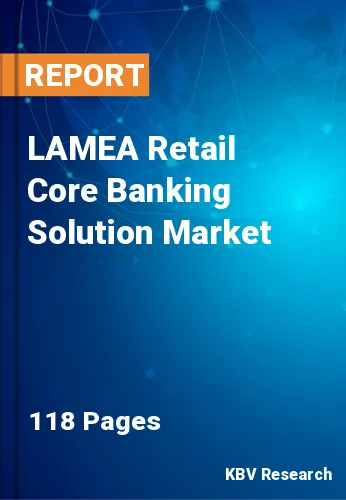The Latin America, Middle East and Africa Retail Core Banking Solution Market would witness market growth of 11.1% CAGR during the forecast period (2022-2028).
Some banks now use Beacons to instantly send customers' smartphones personalized incentives as quickly as they approach the branch. In addition, customers can speak to tellers at some A.T.M.s via live-stream video support if they need more help. Banks employ IoT and other financial apps to address the tension caused by mobile banking in conventional branch banking. Biometric sensors, for example, could collect user information as customers enter the bank and transmit it to the primary system. The B.M.O. Harris Bank tried a branch with such advanced technology without actual staff. In this scenario, a user is technologically or through chatbots led.
When it comes to banking, IoT offers several benefits. First, this provides debtors with services that are dependable and simple to acquire, as well as credit cardholders. Banks can monitor how consumers utilize A.T.M. kiosks in different locations and adjust the number of A.T.M.s installed there based on usage patterns. By putting in kiosks and improving consumers' access to financial services, banks can leverage IoT to deliver on-demand services closer to their clients.
Third, IoT offers consumer data that enables banks to identify their clients' business requirements and value chains, including suppliers, retailers, and distributors. The data also allows the banks to learn more about their clients. As a result, banks can offer value-added services, specialized banking services, and products, and financial help owing to the client information made available by the Internet of Things, ensuring that both the customer and the bank benefit from the arrangement.
The U.A.E. Central Bank oversees the country's thriving domestic banking industry. Following the state's overarching policy, the Central Bank sets monetary, credit, and banking policy and oversees its implementation to support the national economy and currency stability. In addition, it keeps track of the gold and foreign currency holdings of the U.A.E. government, acts as the bank for local banks and represents the U.A.E. government's financial interests at international financial organizations. Islamic banking has grown significantly in recent years and is now a significant part of the financial sector in the United Arab Emirates.
The Brazil market dominated the LAMEA Retail Core Banking Solution Market by Country in 2021; thereby, achieving a market value of $127.4 million by 2028. The Argentina market is showcasing a CAGR of 11.7% during (2022 - 2028). Additionally, The UAE market would register a CAGR of 10.8% during (2022 - 2028).
Based on Component, the market is segmented into Solution (Without Services) and Services. Based on Deployment Mode, the market is segmented into Cloud and On-premise. Based on Organization Size, the market is segmented into Large Enterprises and SMEs. Based on Application, the market is segmented into Regulatory Compliance, Risk Management, Digital Banking, and Others. Based on countries, the market is segmented into Brazil, Argentina, UAE, Saudi Arabia, South Africa, Nigeria, and Rest of LAMEA.
Free Valuable Insights: The Global Retail Core Banking Solution Market is Predict to reach $7.4 Billion by 2028, at a CAGR of 9.8%
The market research report covers the analysis of key stake holders of the market. Key companies profiled in the report include Oracle Corporation, Fiserv, Inc., Temenos AG, Tata Consultancy Services Limited, SAP SE, Infosys Limited, Fidelity National Information Services, Inc. (FIS), Kiya.ai, Jack Henry & Associates, Inc. and Silverlake Axis Ltd.
By Component
By Deployment Mode
By Organization Size
By Application
By Country
Our team of dedicated experts can provide you with attractive expansion opportunities for your business.

